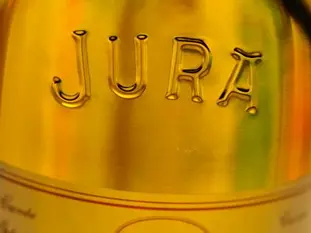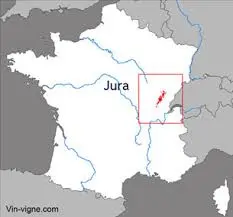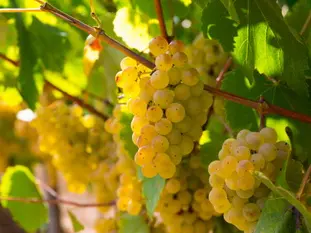This site uses only a few technical cookies necessary for its operation. By continuing to browse, you accept their use.
To find out more...
To find out more...
The delicious complexity of Jura wines

Do you know the wines of the Jura? Maybe not, it's a small appellation, 2000 hectares, with a production of wines that are both very atypical and very typical, even unique for some of them.
Let me tell you a few words about it.
Let me tell you a few words about it.
13 K 4.9/5 (15 reviews)
Keywords for this post:WinesJuraWhiteSavagninVineyardYellow wineTypicityLast modified on: May 14th 2022
The delicious complexity of Jura wines
Where are they?


As their name indicates, they all come exclusively from Franche-Comté, from the department of Jura, along a strip 80 for about 6 km on the slopes that lead from the plain to the Jura plateau.
The best known "capital" is the small town of Arbois, which is often referred to as the "wine of Arbois".
The majority of the wines are made from grape varieties that can only be found in this vineyard with little known names such as trousseau, poulsard or savagnin.
Which wines?

The vineyard produces a little bit all the colors and all the kinds of wines, classic red, white and sparkling wines, as well as 2 delicious products : the straw wine and the macvin which I will speak to you about another time.
But it is mainly white wines, and in particular a kind of "flagship" wine which is the yellow wine, unique and very very atypical.
The savagnin

The great grape variety of the Jura is the savagnin, it is a white grape which is used only to make the wines called "Cotes du Jura" (with or without a Chardonnay part), and especially the famous yellow wine.
It's a quite amazing thing that the yellow wine: we harvest the savagnin only, we vinify, we put in wooden barrels and we wait 6 years that the wine matures, oxidizes and reduces, the famous part of the angels (by the way, they live well the angels with all that they recover :-).

No secret, it is very expensive as a wine, but it is the recognition of a real work of wine making, with a not negligible loss by evaporation.
On the other hand, you don't necessarily need to buy a vin jaune to discover the taste of savagnin, a coteaux du jura is an excellent start, at a very reasonable price.
And the taste?
This is where we come to the complexity of these wines, their amber color goes hand in hand with a unique taste, very dry, with very pronounced aromas of nuts.
Tastes that can be (very) disturbing, especially the first time, where we often have two camps in reaction: "What the hell is this thing?" (or "This is not wine!") and on the other hand "Wow, this is incredible!
A wine merchant friend of mine told me that there are no half measures with savagnin, either you love it or you hate it.
But it is the same with all atypical wines, if you are not warned and you expect a classic white wine, like chardonnay, it can be confusing, but you have to try to go a bit beyond the first nose and the first sip...
And in cooking?

As much as the tasting of a wine from the Jura (yellow or Côtes du Jura) can be surprising the first time, in cooking its presence in a sauce is a contribution that goes alone and brings a lot.
You may have heard the saying "great wine, great dish", it is also true here, of course the famous "Poularde au vin jaune flanquées de morilles" is one of the emblematic dishes of Comtoise cuisine, but in general Savagnin goes very well with creamy dishes, white meats or fish. Another frequent agreement on the great tables, it is the white asparagus and the yellow wine, and well on the perfect agreement in my opinion: yellow wine, some walnuts, a sourdough bread and Comté cheese (of 18 months minimum if possible).
The celebrity
The relative confidentiality of Jura wines does not prevent them from being showcased in beautiful ways, here are some examples:
- The yellow wine "Chateau-Chalon" (named after a small village that has its own AOC) is considered one of the 5 greatest white wines in the world, no less.
- The same yellow wine discovered by Napoleon III during a meal offered by Metternich had dazzled him, convinced that it was an Austrian wine he congratulated (it is said) Metternich, but the prince explained to him that it came in fact from France.
- Arbois wine has been sung by Jacques Brel (Le dernier repas) and Boris Vian, among others.
I hope that these few lines, of course a rather short description, will make you want to taste it, either in a glass or in a recipe.
To sum up: If you don't know Jura wines yet, try one of these days to open a bottle of white Coteaux du Jura in Savagnin grape variety, maybe it will be the beginning of a discovery...
Lasts posts
Butter vs. grease
We often read in a recipe where a pastry is put into a mould that, just before pouring, the mould should be buttered or greased. But what's the difference between these 2 terms?December 1st 20257315
Getting out of the fridge early
Very often when you're cooking, you need to take food or preparations out of the fridge, to use them in the recipe in progress. There's nothing tricky about this: you just take them out of the fridge and use them, usually immediately, in the recipe. But is this really a good method?November 24th 20259845
Who's making the croissants?
When you look at a bakery from the outside, you naturally think that in the bakery, the bakers make the bread, and in the laboratory, the pastry chefs make the cakes. It's very often like that, with each of these professions having quite different ways of working, but sometimes there's also one...November 23th 2025886
Oven height
When we put a dish or cake in the oven, we naturally tend to put it on the middle shelf, and that's what we usually do. But in some cases, this position and height can be a little tricky, so let's find out why.October 8th 20252,5075
The importance of sieving
In recipes that use a fine powder (flour, powdered sugar, etc.), you'll often see the advice to sift before using it. To sift is to pass the powder in question through a sieve (a very fine strainer) before incorporating it into your recipe. It's often advice, but is it really useful?September 3rd 20257,3793
Other pages you may also like
Should asparagus really be cooked in bunches?
You'll probably read recipes here and there explaining how to cook asparagus "en botte", i.e. in a small package (the famous "botte"). Is this really the right way to cook asparagus?May 22th 20247,7275
Choosing a chopping board
It's a no-brainer, surely? If you want a chopping board, just find a piece of wood, and Bob's your uncle! You can happily chop away with a knife and not damage the table or worktop. But in reality, it's a bit more complicated than that. You need to be careful what you are buying, in particular the...May 8th 201250 K4.6
From website to blog
Hello everyone, Today I'm inaugurating the cooking-ez.com "blog". The idea is to have a space for discussion open to everone, but not necessarily linked to a particular recipe or page. I hope the posts will be sufficiently interesting that you'll enjoy reading and discussing them. The...January 1st 201121 K3.9
How to choose a centrifugal juicer
A centrifugal juicer is an appliance designed to extract juice from all kinds of fruit and vegetables. It will produce juice from tomatoes, carrots, apples, pineapple, blackcurrants, etc.April 1st 201145 K4.4
Is it really necessary to cream egg yolks?
Let’s try and answer a question that crops up in cookery and patisserie, even if it verges on the existential: do the egg yolks in a custard recipe really need to be beaten until pale, or not?February 28th 201844 K4.3
Post a comment or question
Follow this page
If you are interested in this page, you can "follow" it, by entering your email address here. You will then receive a notification immediately each time the page is modified or a new comment is added. Please note that you will need to confirm this following.
Note: We'll never share your e-mail address with anyone else.
Alternatively: you can subscribe to the mailing list of cooling-ez.com , you will receive a e-mail for each new recipe published on the site.









